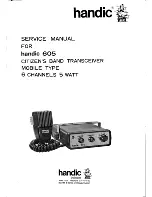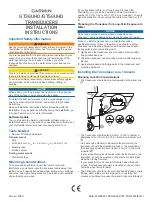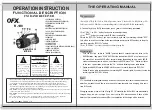
4.0 OPERA
TI
ON
This section is intended to familiarize you with
the various operating features of the transcei
ver. The early subsections describe in detail
the basic operating procedures for the receiver
and transmitter. However, for these to work as
described it is assumed that you have performed
each step in the order given, from the start:
that you have already read
§'2,
and are familiar
with the locations and basic functions of the
various controls and switches; and that the
transceiver has been installed as described in
§3.
If not, please read
§'2
and
§3
now.
Subsections 4.8 through 4. 12 describe the more
complex
operations
involving
programmable
features, memories and scanning. We do not
recommend random experimentation with the
controls until after you have followed these
procedures. Some keys and switches alter or
disable other functions and may cause confusion.
Although this should not damage the equipment,
you may have to turn o ff the transceiver and
press the BACKUP switch (twice) to reset the
memory system (
§3.6 )
if you loose track of opera
tion. If the location or basic function of a
control or switch is unclear, refer to
§'2.
Subsections 4. 13 through 4. 18 offer some sugges-
tions for implementing features
applications. The comments and
these final sections are intended
in different
procedures in
to guide your
own experimentation, rather than to serve as a
last word on the best way to operate: ultimately
it is up to you to choose the best features and
techniques for your own operating preferences.
4.1
Preliminary Steps
Before plugging in the power cord to the wall
outlet, double check that the AC voltage label
on the rear panel match your line voltage. Also,
set the BACKUP switch on (undepressed position)
if it is not already. Set the front panel power
switch to the OFF (undepressed) position.
Connect a microphone, if desired, to the MIC
jack. For CW operation, connect your CW key or
keyer paddles to the KEY jack.
Preset the front panel controls:
MIC, D RIVE
&
NB-----------fully counterclockwise
SQL-----------------------------fully counterclockwise
(but not into the click-stop)
AF------------------------------------ counterclockwise
RF ----------------------------------------fully clockwise
All other controls-----------------------------midrange
All pushbutton switches----------- out (undepressed)
4.2
Initial Power Up, Band Selection
Plug the AC power cord into the wall outlet, and
press the POWE R switch. The meter and display
should light up, with the display indicating the
default settings if the transceiver has not been
used before: LSB (lower sideband mode), VFO-A,
7
.000.00 (MHz). Set the DIM selector (below the
left edge of the display) for comfortable dis
play brightness.
"'
I/ I/ I/
II
'· LI LI LI. LI
LI
Press the BAND/MCH keys (to the right of the
tuning knob) and observe the band changes on the
display. In the default (Ham) mode, the HF ama
teur bands are selected.
1.000.00
1.000.00
�
10.000.00
3.500.0o
�
14. 000. Oo
1. 500. Oo
�
18.000.0o
...
DOWN
28.000.0o
E=i
28.000.0o
18.000.0o
�
1. 500. Oo
rWNJ
14.000.0o
�
3.500.0o
10.000.00
Press the H/G (ENT) key (at the lower left of the
keypad) once. The green GEN indicator just
beneath the frequency display should glow. Now
press the BAND/MCH keys and again observe the
band changes on the display. In this (General
Coverage) mode, the receiving frequency changes
by 500 kHz for each BAND step.
- 16 -
Summary of Contents for FT-767GX
Page 1: ...FT 767GX OPERATING MANUAL YAESU MUSEN CO LTD TOKYO JAPAN...
Page 39: ......















































